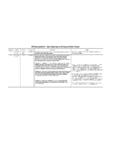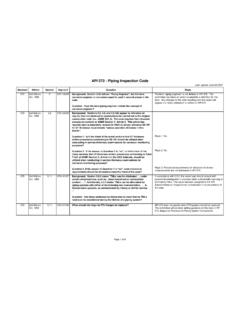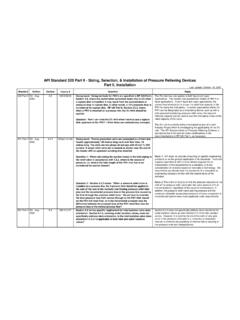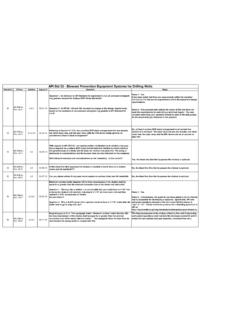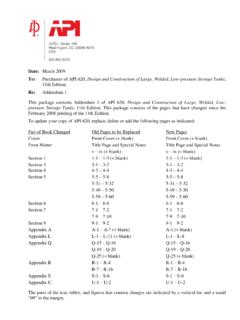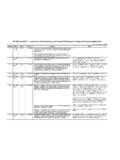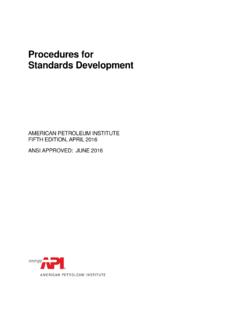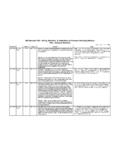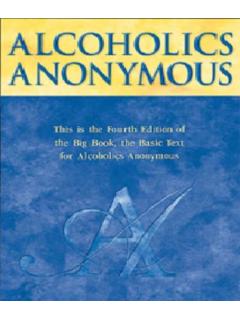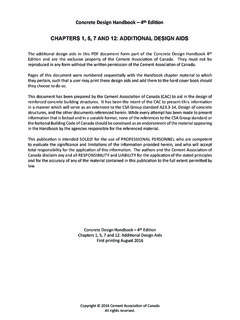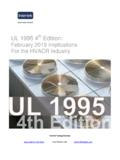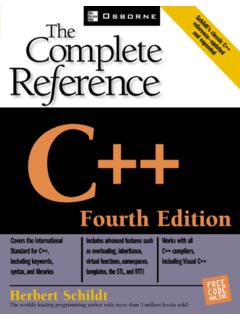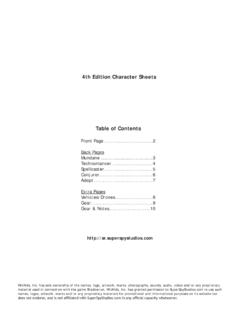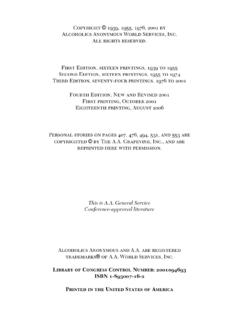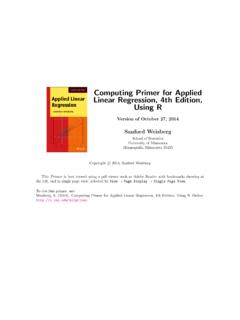Transcription of API Specification 16A, 4th Edition
1 Page 1 API Specification 16A, 4th edition APPROVED INTERPRETATIONS Interpretations Issued for THIS Edition as of: June 2017 (supersedes all previous issue dates) Publication: API Specification 16A, 4th edition , Specification for Drill-through Equipment Publication Date: April 2017 Errata, None Addenda, None [NOTE 1 Interpretations are reviewed and approved by API and become part of the published document Interpretations apply only to the Edition cited above. Interpretations may be used as a basis for change to the subsequent editions of the document NOTE 2 Newly added interpretations are identified in red Section/Table/Figure: Section Question: Section , NOTE: Test results may be used to qualify other blind rams and other fixed bore pipe rams of different nominal pipe sizes.]
2 I interpret this statement as saying that testing a fixed bore pipe ram of a particular pipe size will qualify other fixed bore pipe rams of different nominal pipe sizes as long as the relevant criteria is met. But I don t see any explicit statement that says Fixed bore pipe rams test qualifies blind rams ? Response: No. Both must be tested. In other words, a pipe ram test does not qualify a blind ram. As indicated in Table 20, blind rams must be tested for sealing characteristics, fatigue and temperature. It is important to note the restrictions following Table 19 (bottom of page 43).
3 For example, the change of any essential variable prohibits using the qualification of a different product. API 16A, Section lists metallic insert design and mold design as essential variables. Section/Table/Figure: Section Question: The sentences in question read "The number and location of both part and environmental thermocouples (with controlling and monitoring designations) SHALL be clearly identified. Thermocouples attached to the parts SHALL be used as controlling thermocouples. A minimum of two part thermocouples are required per heat treat batch.
4 " There are two clear SHALL statements, but the last statement that "a minimum of two part thermocouples are required" is not a SHALL statement. Can you confirm the requirement for the number of thermocouples required? Response: Yes. Per the API Style Guide, Table 1, equivalent expressions for statements of requirement that may be in a document include (but are not limited to) the use of is required or any variation. The extracted wording A minimum of two part thermocouples are required per heat treat batch. would clearly meet this criterion and therefore is deemed a requirement.
5 Section/Table/Figure: Section Question: In section , figure 9, the second to last note ends with "..ER = 1 - 1/4 T". All other fractions in the document are shown WITHOUT the dash between unit and fraction, so it is unclear if this is a fraction or a formula, where the dash indicates subtraction. In 3rd Edition , this value was one fourth ( ). Is the ER equal to one minus one fourth (equal to ), or is it one and one fourth (equal to )? Response: No. The ER does not equal one minus one fourth T; Yes. The ER equals one and one fourth T (equal to ). Section/Table/Figure: Section Question: In 16A 3rd Edition , in section , figure , there is a statement which reads When all internal and external surfaces during heat treatment are not within 13mm (1/2 in) of the final surfaces, then ER = 2T.
6 Due to the heat treating process, bolt holes and porting (which may be considered internal or external surfaces) are machined AFTER the process, which means the ER requirement becomes 2T. In 3rd Edition , there was a further statement in section which limited the maximum QTC ER to 5 inches. In 4th edition , the limitation of the ER to 5 inches has been removed (section ), yet the Page 2 requirement for 2T when finished surfaces are not within remains (section , figure 9, last note). For some shapes, this requirement actually requires a QTC larger than the actual part ( , even a sacrificial forging is not sufficient to meet the criteria).
7 This presents a conflict where states that The ER of the QTC shall be equal to or greater than the dimensions of the part it qualifies and the statement in figure 9 that the ER = 2T which can require a QTC greater than the part it qualifies. Per section of the API Document Format and Style Manual, Notes to figures shall not contain requirements or any information considered indispensable for the use of the document which indicates the notes in figure 9 are recommendations, not mandatory requirements. Is the QTC limited to a maximum of a sacrificial part or does a mandatory requirement exist that may cause a QTC to be larger than the part it qualifies?
8 Response: No, the last two lines in Figure 9 are NOT notes, they are part of the overall Figure 9 requirements per API 16A, Section The items cited are statements of fact that include mathematical expressions. These are to be used along with other applicable sections of the document: 1) Use of ER Method in Figure 9 per the shall statement in API 16A, Section , The dimensions of a QTC for a part shall be determined using the following ER method. 2) The ER of a part shall be determined using the actual per API 16A, Section , with Figure 9 illustrating the basic models for determining the ER of simple solid and hollowed parts and more complicated equipment.
9 3) The ER of the QTC shall be equal to or greater per API 16A, Section Section/Table/Figure: Table 18 Question 1: Table 18 contains a note "only one test is required for a product family of functionally similar design to qualify PR1. Is scaling allowed per product family? Response1: No. Product scaling is not permitted. Sealing characteristic data per 16A, Section may be scaled in order to create needed data for different operator sizes, per Tables 20 and 21. Furthermore, note (a) of Table 18 only applies to the ram access test ( ) for PR1 rams. Question 2: If yes, can we say that PR1 is comparable with API 16A 3rd Edition ?
10 Response 2: No. See above. Furthermore, there is no expectation that 16A ( 4th edition ) PR1, is meant to be the equivalent to 16A (3rd Edition ). For the full interpretations list including any additional background information that may apply (if you get a request box for user name and password, just click the x in the upper right corner), see: For instructions on how to submit a request for interpretation to API (note that per API Policy, interpretation requests may take up to 12 months to be reviewed and interpretations issued) see: For an up-to-date list of errata and addenda for this document, see.
